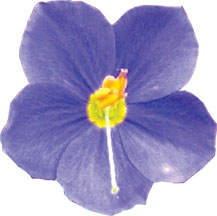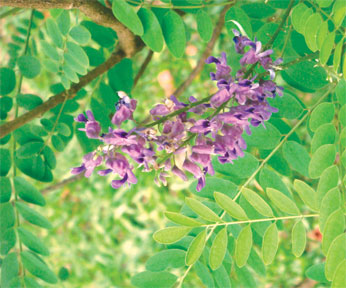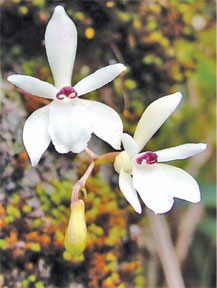|
Alien plants on the increase:
Lanka, a repository of endemic flowers
By Dhaneshi YATAWARA
 |
|
Cannonball flowers
(Sal) |
 Flowers; they are with us throughout our life - in joy and in grief.
We choose them to express our feelings and flowers have neither
complained nor shown their joy over our decisions. Be it on the Mal
Asana of a temple or among the garbage, flowers are beautiful to the
human eye wherever they may be. A bouquet of flowers would always heal
the sick and a grieving heart. Flowers; they are with us throughout our life - in joy and in grief.
We choose them to express our feelings and flowers have neither
complained nor shown their joy over our decisions. Be it on the Mal
Asana of a temple or among the garbage, flowers are beautiful to the
human eye wherever they may be. A bouquet of flowers would always heal
the sick and a grieving heart.
A place with brightly coloured flowers, beautiful trees and abundant
greenery is a paradise, for us. And undoubtedly, Sri Lanka is a
paradise.
The island nation holds the record of the world’s highest rate of
endemism in the world of flowers. Sri Lanka's fauna and flora have the
world's highest rate of endemism with 16 percent of its fauna and nearly
30 percent of its flowering plants being endemic to the country.
According to statistics, on an average, a little over 17 endemic
plants can be found in a 100 square kilometre area in the Western Ghats
and Sri Lanka.
Flowers contain the reproductive parts of a flowering plant,
scientifically known as ‘Angiosperms’. Since plants cannot move from
place to place, many elaborate methods are devised by nature that helps
identify a plant.
“It is because certain characteristics - such as the number of
petals, the number of stamens, the arrangement of petals and the shape
of bunches - are constant for a particular type of plant that botanists
primarily use flower characteristics in identifying plants,” according
to the book ‘Flowering Plants - commonly encountered in Sri Lankan
habitats’ written by Dr. Sriyani Miththapala, Dr. Siril Wijesundara and
Dr. Janaki Galappatti.
Flowering plants
 |
|
Sophora violacea is found
only in the Royal Botanical Gardens in Peradeniya and is
believed to be already extinct in the wild. The flower has
not been reportedly observed in the wild in the recent past.
Pic: Sudam Gunasinghe |
 |
|
Orchids and above
Binara flower |
Botanists categorise this repository of flowering plants into
different segments. Dr. Siril Wijesundara, Director General of the
Department of Botanical Gardens said, “Flowering plants can be seen in
four categories. Native and Endemic plants are two of the four types
which we have heard of often and know exactly what they mean. The other
two categories would be Naturalised and Alien plants. Alien plants are
species, subspecies or lower taxa introduced outside of their natural
range (past or present) and outside their natural dispersal potential.”
Naturalised plants, as Dr Wijesundara explained, are alien plant species
that reproduce and sustain populations without direct intervention by
humans, often producing plentiful offspring.
These are alien plants that sustain self-replacing populations for at
least 10 years without direct intervention by people through seeds,
tillers, tubers, bulbs or plant fragments which are capable of
independent growth.
In Sri Lanka, the number of alien plants is increasing and there are
nearly 200 naturalised plants identified by botanists. Fortunately or
not, many of the beautiful flowering plants we have in our surroundings
are introduced species, according to Dr Wijesundara. Among the invasive
plants we find in Sri Lanka, 37 species were introduced more than a 100
years ago. Another 14 species were introduced between the past 100 and
50 years and seven had been introduced during the past 50 years.
Habitats being destroyed
As the three authors explain in the book ‘Flowering plants’, alien
plants that can replace native plants and destroy habitats are spreading
at a dangerous pace. Farmers plant exotic crops and horticulturists
transplant ornamental species. In Sri Lanka, Mesquite (Prosopis
juliflora) and Prickly Pear (Opuntia speices) have spread in the Bundala
National Park, replacing its native vegetation, while ‘Lantana’ is doing
the same at the Udawalawe National Park, according to the book.
 |
|
Water lilies |
 |
|
Wrightia
antidysenterica, Wal ldda which is endemic to Sri Lanka is
also used as an ornamental plant |
Every time a person brings in an untreated plant to this country, it
could be facilitating the spread of invasive plants.
According to Dr. Wijesundara, there are nearly 1,000 endemic
flowering plants in Sri Lanka that are recorded and identified. The
island is home to 18 endemic plant genera. The flowering plants of Sri
Lanka belong to 1,369 genera and 3,771 species.
As a direct consequence of human activities, the possiblity of
species facing extinction is now 1,000 times greater than the accepted
norms, the authors explain in the book, referring to global data.
Accordingly, in 2009, the International Union for Conservation of
Nature (IUCN) listed 10,876 flowering plants as threatened with
extinction as a result of various human activities. Sri Lankan flowering
plants numbering 675 have been listed here as threatened.
|

